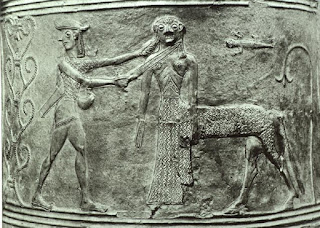This is an image from Jim Jarmusch's recent movie "The Dead don't Die." A standard zombie movie, but well done and with some interesting quirks, one is the image above. When I saw it, my mind immediately went to Cellini's "Medusa," the piece of statuary still standing today in Florence after it was made in the mid-1500s. Maybe it is the source of inspiration for Jarmusch's scene.
Here we don't have a zombie hunter beheading an undead creature but the hero Perseus is doing something similar by beheading Medusa, supposed to be a female monster. I described Cellini's work in
a previous post, but it was not Cellini who invented this theme. It is way more ancient than the Renaissance. It was common in antiquity.
Here is a fresco coming from
a Roman villa showing a rather fat Perseus happy to have just beheaded the evil Medusa.
Just to show how common the theme was, here is a cameo, probably coming from early imperial Roman times, with another Perseus holding the head of Medusa in his hand. It is presently
at the Getty museum.
And the theme is even more ancient than classic antiquity but, initially, it was more common to show just the head of Medusa or the act of beheading her, as
in this relief said to have been made around 650 BCE
So, the idea of the hero triumphantly showing the severed head of a woman is relatively modern and it has something to do with what we call "civilization." It never was among the most popular themes of ancient art, but it surely had its space and a certain dignity that made it acceptable.
In relatively modern times, for instance, the Italian sculptor Antonio Canova (
1757- 1822) was probably inspired by Cellini when he reproposed the old theme, as you can see here:
About this piece, it must be said that Cellini remains an unequaled master and that Canova's interpretation of the scene is at best acceptable but has nothing of the inner power of Cellini's work. But so it goes: art is more often imitation than creation.
In our times, the idea that it is a heroic thing to behead a woman seems to have become unfashionable, fortunately. Surely, no one would propose a piece of statuary showing the severed head of a woman to stand in the central square of a city -- as we have in Florence with Cellini's Perseus. But the theme remains alive, it is just that the hero has been turned into the villain of horror movies and dark comics. Here is an example
from the work of Johnny Craig.
And here is the same scene in "Scary Movie" (2000)
Many more images of this kind can be found on the Web, but the idea is not limited to fantasy. It is sometimes projected on people or groups whom we perceive as evil. Here is a photo that became viral on the Web.
It is said to depict an ISIS fighter who killed and beheaded a Kurdish female fighter. It is, most likely, a fake and the whole story is mostly fantasy. But it is curious how the theme recurs over and over. It is something deep in our collective mind, probably leading to nothing bad as long as it is fantasy, but in our times of fake news, the line between reality and fantasy is often blurred. And this is how we keep moving toward the future.













